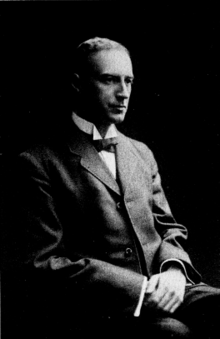Wallace Clement Sabine
| Wallace Clement Sabine | |
|---|---|
 |
|
| Born | June 13, 1868 |
| Died | January 19, 1919 (aged 50) |
| Nationality | American |
| Fields | Acoustics |
| Alma mater | Harvard University |
| Doctoral advisor | John Trowbridge |
| Doctoral students | Percy Bridgman |
Wallace Clement Sabine (June 13, 1868 – January 10, 1919) was an American physicist who founded the field of architectural acoustics. He graduated from Ohio State University in 1886 at the age of 18 before joining Harvard University for graduate study and remaining as a faculty member. Sabine was architectural acoustician of Boston's Symphony Hall, widely considered one of the two or three best concert halls in the world for its acoustics.
Sabine's career is the story of the birth of the field of modern architectural acoustics. In 1895, acoustically improving the Fogg Lecture Hall, part of the recently constructed Fogg Art Museum, was considered an impossible task by the senior staff of the physics department at Harvard. The assignment was passed down until it landed on the shoulders of a young physics professor, Sabine. Although considered a popular lecturer by the students, Sabine had never received his Ph.D. and did not have any particular background dealing with sound.
Sabine tackled the problem by trying to determine what made the Fogg Lecture Hall different from other, acoustically acceptable facilities. In particular, the Sanders Theater was considered acoustically excellent. For the next several years, Sabine and a group of assistants spent each night moving materials between the two lecture halls and testing the acoustics. On some nights they would borrow hundreds of seat cushions from the Sanders Theater. Using an organ pipe and a stopwatch, Sabine performed thousands of careful measurements (though inaccurate by present standards) of the time required for different frequencies of sounds to decay to inaudibility in the presence of the different materials. He tested reverberation time with several different types of Oriental rugs inside Fogg Lecture Hall, and with various numbers of people occupying its seats, and found that the body of an average person decreased reverberation time by about as much as six seat cushions. Once the measurements were taken and before morning arrived, everything was quickly replaced in both lecture halls, in order to be ready for classes the next day.
...
Wikipedia
